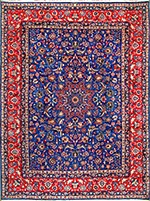Textiles Studies
Date of this Version
2008
Document Type
Article
Citation
This article appeared on pages 17-32 of the November/December 2008 print edition of Saudi Aramco World. Online archive: https://archive.aramcoworld.com/issue/200806/2009.calendar.warps.wefts.htm
Abstract
The interlacing of warp and weft defines a woven fabric. The weaver strings warp yarns onto a loom, a frame designed to hold the warps parallel and taut, and then introduces the wefts sequentially. The process is weaving; the result is a textile.
When we think of textiles, we most often think of garments to clothe our bodies and furnishings to supply our domestic needs. But throughout history, textiles have also played a primary role in fashion, drawing on not only color and pattern but also draping qualities and the effects of tailoring to cover (or show off) the body. As furnishings, textiles serve as covers and as hangings, to cover tables and to decorate floors. In architecture, fabric is used for tents and as wall dividers, sunshades and even fences. In traditional societies where trees and paper are scarce, textiles store and transport belongings as well as grains, flour, salt and other commodities. For animal management, textiles are tethers, saddlecloths, coverings and girth straps, as well as ropes and cords. With such diversity in their forms and functions, textiles convey massive amounts of information about cultures and economies. Representing sophisticated understandings of materials and their physical properties, as well as technologies for their manipulation, textiles embody human ingenuity. Because they have been traded far and wide, to study textiles is to learn about the world.
Included in
Art and Materials Conservation Commons, Art Practice Commons, Fiber, Textile, and Weaving Arts Commons, Indigenous Studies Commons, Museum Studies Commons


Comments
Copyright © 2008 Aramco Services Company.